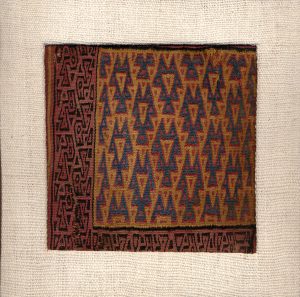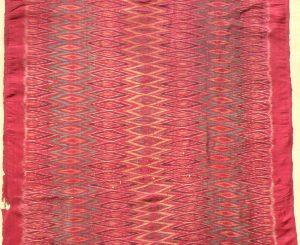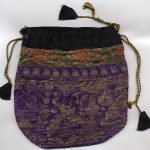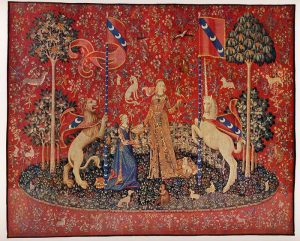COLOR IN ANCIENT TEXTILES
Many sources of inspiration come from ancient textiles found in many countries. Other sources come from observing nature. My childhood was spent in the lakes, forests and marshlands of Northern Ontario. Our house was on the lake and a big living room window facing the lake provided me with hours of drawing and painting. My mother gave me her old lipstick tubes, make-up and mascara to paint with. I painted water scenes and the sunlight reflecting on the marshland. At the Institute of Applied Arts in Montreal (old name: École du meuble de Montréal), I studied painting, sculpture and architecture. I was awarded Master of Fine Arts degree in 1992 at the Université du Québec in Montréal. My focus on color has continued through my passion for collecting ancient textile art.
I would like to present to you the ancient textiles that have influenced my passion for textile art and for using ancient dyes in my work.
This is a Nazca tapestry fragment from ancient Peru.
From Wikipedia we learn that :
“The Nazca and Paracas cultures flourished between approximately 1200 BC to 800 AD. Strongly influenced by the preceding Paracas culture, which was known for extremely complex textiles, the Nazca produced many ceramics, textiles, and geoglyphs. The Paracas culture was an Andean society with an extensive knowledge of irrigation and water management and that made significant contributions in the textile arts. The Paracas textiles include many complex weave structures, as well as elaborate plaiting and knotting techniques……….
Different color schemes characterize the textiles of Paracas Cavernas, early Paracas Necropolis and later Nazca-related styles. The dyes used came from many regions of the Andes and are an example of reciprocity, as people from different altitudes traded with one another for different goods. The color red comes from the cochineal bug found on the prickly pear cactus. The cochineal was ground up with mortar and pestle to create a red pigment. Yellow dyes could be made from the qolle tree and quico flowers, while orange dyes can be extracted from a type of moss called beard lichen. For the color green the most common plant used is the cg’illca, mixed with a mineral called collpa. While blues are created from a tara, the deeper a hue of blue, the more the mineral collpa was added. The process of creating dyes could take up to several hours. Then it could take another two hours for women to boil and dye the fibers. This work was followed by spinning and weaving the fibers.”

This is a Bali_Selendang from Singaraja.
From Wikipedia we learn that : “Silk, Early 20th cent 350 x 50 cm Collection of Balique Arts of Indonesia20121123 3.JPG Photo by Chris Hazzard – Own work, CC BY-SA 3.0, https://commons.wikimedia.org/w/index.php?curid=22822480Ikat of the warp, called endek in Bali. Very early silk selendang 350 x 50 cm. As bbefits its age it is in very frail condition. From the collection of Balique Arts of Indonesia”

From the Wikipedia website, we learn that : “Balinese textiles are reflective of the historical traditions of Bali, Indonesia. Bali has been historically linked to the major courts of Java before the 10th century ………. Bali therefore may be seen as a repository not only of its own arts but those of Java in the pre-Islamic 15th century. ……… The use of textile is a living tradition and so is in constant change. It will also vary from one district to another. For the most part old cloth (excepting the especially sacred) are not venerated for their age. New is much better. In the tropics cloth rapidly deteriorates and so virtue is generated by replacing them.
………. Beginning with the yarn and the woven cloth, they are a medium through which the divine nature of the universe and its material manifestations are recognized and expressed. Cloth is central to all Balinese spiritual activities.”

The Lady and the Unicorn is a series of 6 tapestries that I visited at the Musée de Cluny in Paris. It was woven around 1500. I was deeply moved by the beauty of this handwoven art made from yarn that was colored with ancient natural dyes. From the Wikipedia website, we learn that :
“The Lady and the Unicorn (French: La Dame à la licorne) is the modern title given to a series of six tapestries created in the style of mille-fleurs (“thousand flowers”) and woven in Flanders from wool and silk, from designs (“cartoons”) drawn in Paris around 1500. The set is on display in the Musée de Cluny in Paris.”
